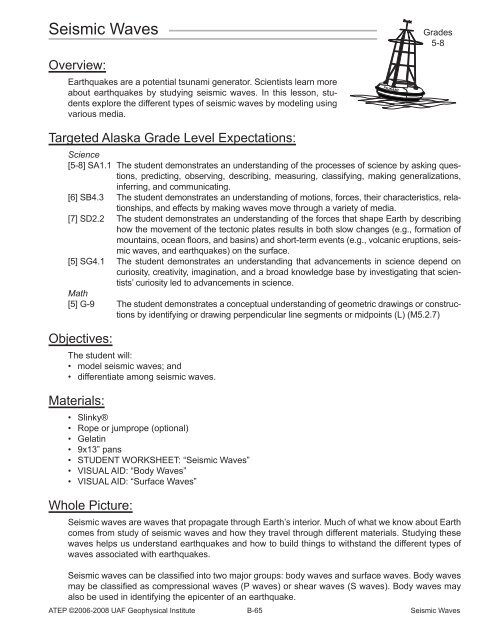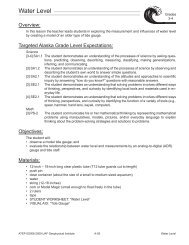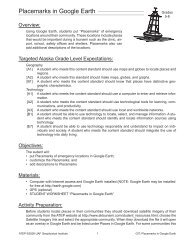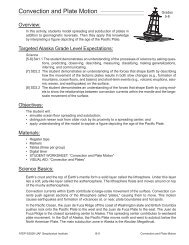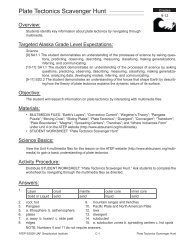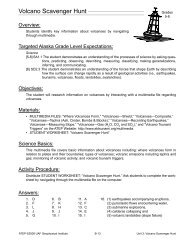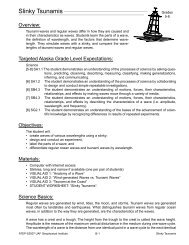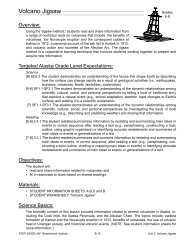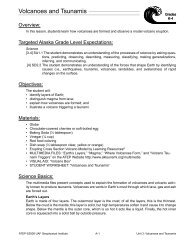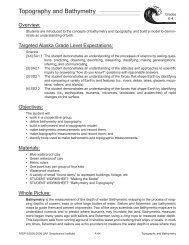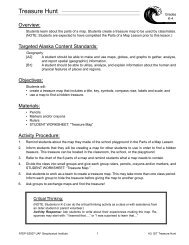Seismic Waves
Seismic Waves
Seismic Waves
Create successful ePaper yourself
Turn your PDF publications into a flip-book with our unique Google optimized e-Paper software.
<strong>Seismic</strong> <strong>Waves</strong><br />
Grades<br />
5-8<br />
Overview:<br />
Earthquakes are a potential tsunami generator. Scientists learn more<br />
about earthquakes by studying seismic waves. In this lesson, students<br />
explore the different types of seismic waves by modeling using<br />
various media.<br />
TSUNAMI<br />
Targeted Alaska Grade Level Expectations:<br />
Science<br />
[5-8] SA1.1 The student demonstrates an understanding of the processes of science by asking questions,<br />
predicting, observing, describing, measuring, classifying, making generalizations,<br />
inferring, and communicating.<br />
[6] SB4.3 The student demonstrates an understanding of motions, forces, their characteristics, relationships,<br />
and effects by making waves move through a variety of media.<br />
[7] SD2.2 The student demonstrates an understanding of the forces that shape Earth by describing<br />
how the movement of the tectonic plates results in both slow changes (e.g., formation of<br />
mountains, ocean floors, and basins) and short-term events (e.g., volcanic eruptions, seismic<br />
waves, and earthquakes) on the surface.<br />
[5] SG4.1 The student demonstrates an understanding that advancements in science depend on<br />
curiosity, creativity, imagination, and a broad knowledge base by investigating that scientists’<br />
curiosity led to advancements in science.<br />
Math<br />
[5] G-9 The student demonstrates a conceptual understanding of geometric drawings or constructions<br />
by identifying or drawing perpendicular line segments or midpoints (L) (M5.2.7)<br />
Objectives:<br />
The student will:<br />
• model seismic waves; and<br />
• differentiate among seismic waves.<br />
Materials:<br />
• Slinky®<br />
• Rope or jumprope (optional)<br />
• Gelatin<br />
• 9x13” pans<br />
• STUDENT WORKSHEET: “<strong>Seismic</strong> <strong>Waves</strong>”<br />
• VISUAL AID: “Body <strong>Waves</strong>”<br />
• VISUAL AID: “Surface <strong>Waves</strong>”<br />
Whole Picture:<br />
<strong>Seismic</strong> waves are waves that propagate through Earth’s interior. Much of what we know about Earth<br />
comes from study of seismic waves and how they travel through different materials. Studying these<br />
waves helps us understand earthquakes and how to build things to withstand the different types of<br />
waves associated with earthquakes.<br />
<strong>Seismic</strong> waves can be classified into two major groups: body waves and surface waves. Body waves<br />
may be classified as compressional waves (P waves) or shear waves (S waves). Body waves may<br />
also be used in identifying the epicenter of an earthquake.<br />
ATEP ©2006-2008 UAF Geophysical Institute B-65 <strong>Seismic</strong> <strong>Waves</strong>
P <strong>Waves</strong><br />
P waves are the faster of the two waves; they can travel through solid rock and liquid, as well as air.<br />
As a P wave travels through a medium (material), it causes particles to move in the same direction as<br />
the wave energy is traveling. As the waves pass through the medium, they cause compressions<br />
(shortening) and dilations (expansions). Slinkies may be used to model this type of wave.<br />
P Wave<br />
Compressions<br />
Dilations<br />
Undisturbed medium<br />
Direction of wave propagation<br />
P Wave in a Slinky®<br />
Direction of<br />
particle motion<br />
Direction of<br />
wave propagation<br />
Compression<br />
Dilation<br />
Compression<br />
ATEP ©2006-2008 UAF Geophysical Institute B-66 <strong>Seismic</strong> <strong>Waves</strong>
S <strong>Waves</strong><br />
S waves are slower than P waves. S waves only move through solid rock. As this type of wave passes<br />
through a medium, particles move perpendicular to the direction of the wave’s energy path. Slinkies<br />
and rope may also be used to model this type of wave.<br />
S Wave<br />
Wavelength<br />
Direction of<br />
wave propagation<br />
S Wave in a Slinky®<br />
Direction of<br />
particle motion<br />
Direction of<br />
wave propagation<br />
ATEP ©2006-2008 UAF Geophysical Institute B-67 <strong>Seismic</strong> <strong>Waves</strong>
Surface <strong>Waves</strong><br />
P and S -waves arriving at the free surface generate waves that propagate parallel to the surface.<br />
These resulting surface waves may be classified as Love or Rayleigh <strong>Waves</strong>.<br />
Love <strong>Waves</strong><br />
Love waves are named after the mathematician, A.E.H. Love, who devised the model of this wave in<br />
1911. Love waves are the faster waves of the two types of surface waves. As Love waves propagate<br />
across the surface of Earth, the particles move from side to side, perpendicular to the path of the<br />
wave’s energy.<br />
Love wave<br />
Rayleigh waves<br />
Rayleigh waves are the other type of surface wave. These are also called “ground rolls” in earthquakes<br />
and are similar to water waves. The difference between water waves and Rayleigh waves is<br />
that the particle oscillations in water waves move in a clockwise direction and the particles in the<br />
Rayleigh waves (solids) move in a counter-clockwise direction. As this wave moves through the solid<br />
surface of the Earth, the land moves up and down in the direction of the wave’s energy path. These<br />
waves are named after Lord Rayleigh who used math to predict the existence of this wave.<br />
Rayleigh wave<br />
Activity Preparation:<br />
Prepare enough gelatin in 9x13 pans so that each pair of students can have their own strip (approximately<br />
9” x 2-3”) of gelatin. Use a recipe similar to Jell-o Jigglers.<br />
ATEP ©2006-2008 UAF Geophysical Institute B-68 <strong>Seismic</strong> <strong>Waves</strong>
Activity Procedure:<br />
1. Explain students will study seismic waves. <strong>Seismic</strong> waves are waves that propagate through Earth’s<br />
interior. Much of what we know about Earth comes from study of seismic waves and how they travel<br />
through different materials. Studying these waves helps us understand earthquakes and how to build<br />
things to minimize damage from earthquakes. Explain the terms perpendicular and parallel and their<br />
relationship to the propagation of energy and motion of particles.<br />
2. Explain students will observe models of seismic waves. To guide students through the various waves,<br />
make a graphic organizer on the board similar to the one below. Fill in the information in italics as you<br />
progress through the demonstrations. You may require that students record their own notes.<br />
<strong>Seismic</strong><br />
<strong>Waves</strong><br />
Body<br />
Surface<br />
Type of Wave: Compressional (P)<br />
Description of motion:<br />
Compressions and dilations in the direction<br />
of the wave’s energy path.<br />
Example:<br />
Slinky or sending a wave down a row of<br />
people standing tall.<br />
Type of Wave: Love<br />
Description of motion:<br />
Particles move perpendicular to the<br />
direction of the wave’s energy path across<br />
Earth’s surface.<br />
Example:<br />
Gelatin shaken from side to side.<br />
Type of Wave: Shear (S)<br />
Description of motion:<br />
Particles move perpendicular to the<br />
direction of the wave’s energy path.<br />
Example:<br />
Rope, slinky, or sending a wave down a row<br />
of people as they bend at the waist.<br />
Type of Wave: Rayleigh<br />
Description of motion:<br />
Particle motion is elliptical, similar to water<br />
waves.<br />
Example:<br />
Gelatin<br />
3. Begin with body waves. Share the information from the Whole Picture section and display VISUAL<br />
AID: “Body <strong>Waves</strong>.” Model the waves using the following media. Point out the direction of wave movement<br />
and the direction of particle motion for each wave.<br />
• Slinkies: Ask students to pair up with each person holding one end of the slinky. To model a P<br />
wave, one person holds the end of the slinky with one hand then hits that hand with their other<br />
hand. To model a S wave, one person moves his or her hand up and down to generate a wave.<br />
This is the same motion used to generate an S wave through a rope.<br />
• Students play the role of particles. They line up, shoulder to shoulder, with arms across each<br />
other’s shoulders. To model a P wave, the teacher pushes the person at the end of the line. The<br />
wave should propagate through the line. To model an S wave, the teacher has the person at the<br />
end of the line bend forward at the waist.<br />
4. For the surface waves, share the information from the Whole Picture section and display VISUAL AID:<br />
“Surface <strong>Waves</strong>.” Distribute a strip of gelatin to each pair of students. To model Love waves, students must<br />
move one end from side to side. To model Rayleigh waves, students should tap the top of one end.<br />
5. Distribute STUDENT WORKSHEET: “<strong>Seismic</strong> <strong>Waves</strong>” for student completion.<br />
ATEP ©2006-2008 UAF Geophysical Institute B-69 <strong>Seismic</strong> <strong>Waves</strong>
Extension Idea:<br />
Use a stopwatch to compare the velocity of P wave and S wave propagation through a slinky and a<br />
line of students. Students should discover that the P wave propagates faster than an S wave.<br />
Answers:<br />
1. <strong>Seismic</strong> waves are waves that propagate through Earth’s interior.<br />
2. Much of what we know about Earth comes from study of seismic waves and how they travel<br />
through different materials. Studying these waves helps us understand earthquakes and how to<br />
build things to withstand the different types of waves associated with earthquakes.<br />
3. P<br />
4. S<br />
5. L<br />
6. P<br />
7. S<br />
8. R<br />
9. L and R<br />
10. P and S<br />
11. L<br />
12. P<br />
13. P and S<br />
14. P<br />
15. S and L<br />
16. R<br />
17. L<br />
18. P<br />
Lesson Information Sources:<br />
Braile, L. (2006). <strong>Seismic</strong> <strong>Waves</strong> and the Slinky: A Guide for Teachers. The IRIS Consortium.<br />
Accessed January 7, 2008 at http://web.ics.purdue.edu/~braile/edumod/slinky/slinky.htm.<br />
Lillie, R.J. (1999). Whole Earth Geophysics: An Introductory Textbook for Geologists and Geophysicists.<br />
Upper Saddle River, N.J.: Prentice Hall.<br />
ATEP ©2006-2008 UAF Geophysical Institute B-70 <strong>Seismic</strong> <strong>Waves</strong>
Name:____________________________________<br />
<strong>Seismic</strong> <strong>Waves</strong><br />
Student Worksheet<br />
TSUNAMI<br />
Grades<br />
5-8<br />
1. What are seismic waves?<br />
_____________________________________________________________________________<br />
_____________________________________________________________________________<br />
2. Why study seismic waves?<br />
_____________________________________________________________________________<br />
_____________________________________________________________________________<br />
Write P (P wave), S (S wave), L (Love Wave) and/or R (Rayleigh Wave) as they apply to each picture or<br />
statement below. [graphics: please remove the name on the wave pictures]<br />
3. ____ 4. ____<br />
Compressions<br />
Undisturbed medium<br />
5. ____ 6. ____<br />
Dilatations<br />
7. ____ 8. ____<br />
9. ____ and ____ are surface waves. 10. ____ and ____ are body waves.<br />
11. ____ is the fastest surface wave. 12. ____ is the fastest body wave.<br />
13. ____ and ____ are used to determine the<br />
epicenter of an earthquake.<br />
15. ____ and ____ Particle motion is perpindicular<br />
to the direction of wave energy.<br />
17. ____ In an earthquake, this type of wave<br />
causes the land to move side to side.<br />
14. ____Particle motion and direction of wave<br />
energy are parallel.<br />
16. ____ Also called a “ground roll.” Particles move in<br />
a circular motion as a wave passes through.<br />
18. ____ This type of wave has compressions and<br />
dilations as energy passes through a medium.<br />
ATEP ©2006-2008 UAF Geophysical Institute B-71 <strong>Seismic</strong> <strong>Waves</strong>


